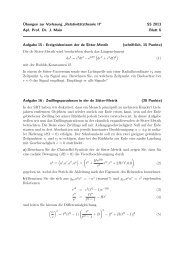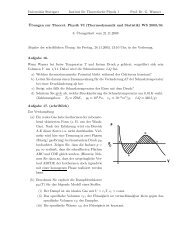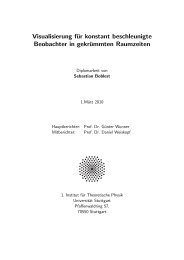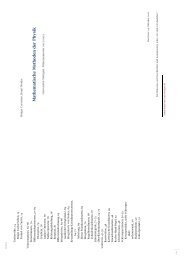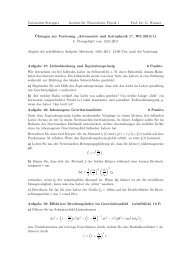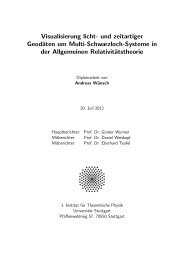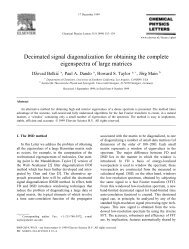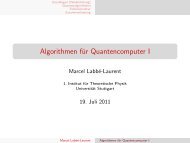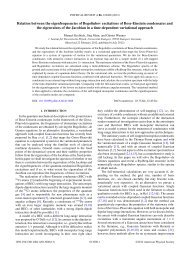The Gödel universe - Institut für Theoretische Physik der Universität ...
The Gödel universe - Institut für Theoretische Physik der Universität ...
The Gödel universe - Institut für Theoretische Physik der Universität ...
Create successful ePaper yourself
Turn your PDF publications into a flip-book with our unique Google optimized e-Paper software.
Obviously, general solutions of the geodesic equations<br />
can be mapped onto other general solutions as well.<br />
<strong>The</strong>refore, we consi<strong>der</strong> arbitrary initial conditions as<br />
above and a desired destination position x µ<br />
1 . <strong>The</strong> component<br />
x µ<br />
0 is rotated around the z-axis until ϕ = π/2 is<br />
reached, isometrically translated along ξ µ<br />
1 to map onto<br />
the desired radial coordinate r = xr 1, then rotated to<br />
the destination angular coordinate ϕ = x ϕ<br />
1 , and finally<br />
isometrically translated in time and the z-coordinate to<br />
arrive at x µ<br />
. Again, the initial direction is only rotated<br />
1<br />
due to the Killing vector field ξ µ<br />
1 by an angle F(˜η1), where<br />
˜η1 = ln<br />
<br />
r2 1 + r2 <br />
G /2 + r1 r2 1 + r2 <br />
G<br />
r2 0 + r2 G /2 + r0<br />
r 2 0 + r 2 G<br />
. (42)<br />
Numerical implementations of this procedure and the<br />
general solution to the geodesic equations yield identical<br />
results.<br />
B. Mapping of the <strong>Gödel</strong> horizon<br />
Because <strong>Gödel</strong>’s <strong>universe</strong> is homogeneous, every observer<br />
O,A or B can legitimately declare his position<br />
as the origin of a coordinate system, where the line element<br />
takes the form of eq. (1). This definition yields an<br />
equivalent formulation of the <strong>Gödel</strong> horizon. Fig. 4 indicates<br />
how these horizons are shaped. <strong>The</strong> <strong>Gödel</strong> horizon<br />
around any point is the convex hull of all lightlike<br />
geodesics starting there. Furthermore, the horizon itself<br />
is a closed null curve (CNC), because ds 2 = 0 along the<br />
<strong>Gödel</strong> radius. We could use the general solution to the<br />
geodesic equations to calculate the exact shape. However,<br />
the usage of finite isometric transformations is by<br />
far more elegant.<br />
Due to the homogeneity of the spacetime, each observer<br />
states that ’his’ horizon is circular within the (xy)plane.<br />
Fig. 10 shows three different horizons. Each horizon<br />
is depicted with respect to the coordinate system of<br />
the observer O. <strong>The</strong> observer A results from an isomet-<br />
ric transport of O along ξ µ<br />
4 with η = η1, eq. (41), and<br />
using r0 = rG. Observer B is subject to a similar transformation,<br />
where η = 2η1.<br />
y<br />
O A B<br />
FIG. 10: Three horizons of three different observers O,A<br />
and B. Crosshatched regions mark common causality regions.<br />
Note that O and B do not share a common region.<br />
x<br />
12<br />
We find that observer O and A share a common causality<br />
region marked by the left crosshatched area. A traveler<br />
T moving arbitrarily in this region will not travel<br />
through time from both observers’ perspectives. Observers<br />
A and B share a similar region, but the horizons<br />
O and B are merely tangential to each other. Hence, motion<br />
restricted to the horizon around O can be causality<br />
violating but not visible for the observer B. Furthermore,<br />
only the observer A is jointly visible to the observer O<br />
as well as B. Note that each horizon is circular for the<br />
corresponding observer and only appears deformed due<br />
to the distortion caused by the chosen set of coordinates.<br />
C. Mapping of worldlines and generation of CTCs<br />
In this section we will discuss how worldlines are isometrically<br />
transformed. This will be used to generate<br />
interesting closed timelike curves (CTCs) from a circular<br />
set of worldlines, where t(λ) is constant.<br />
1. Circular CTCs<br />
In Sec. II A, we reviewed that the light cones beyond<br />
the <strong>Gödel</strong> horizon intersect the t = const. plane. A traveler<br />
can propagate into his own local future but into the<br />
past of an observer located at the origin of the coordinate<br />
system (compare Fig. 2). <strong>The</strong>se CTCs are circles with<br />
constant coordinate time<br />
x t = const, x r = R = const, x ϕ = ωτ, x z = 0, (43)<br />
where R ≥ rG. We generate CTCs when we require that<br />
ut is zero. To find the corresponding direction in the<br />
local frame of reference, eqns. (12), we transform a local<br />
vector to the coordinate representation:<br />
u t = 1<br />
c u(0) √<br />
2r 1<br />
− <br />
rGc 1 + (r/rG) 2 u(2) , (44a)<br />
u r = 1 + (r/rG) 2u (1) , (44b)<br />
u ϕ 1<br />
=<br />
r 1 + (r/rG) 2 u(2) , (44c)<br />
u z = u (3) . (44d)<br />
<strong>The</strong> circular CTCs are then constructed when setting<br />
u t = u r = u z = 0 in the equations above. This results in<br />
a local timelike four-velocity u (a) = (γc,0,γvϕ,0), where<br />
the spatial velocity is given by<br />
<br />
1<br />
vϕ = c<br />
2 [(rG/R) 2 + 1] ≤ c, (45)<br />
and the non-zero component of the four-velocity u µ is<br />
u ϕ = ω = c 1<br />
<br />
R (R/rG) 2 . (46)<br />
− 1




